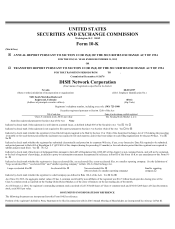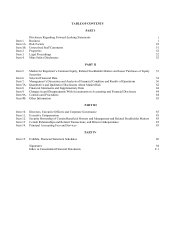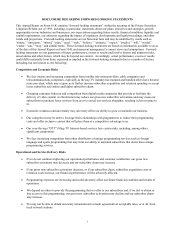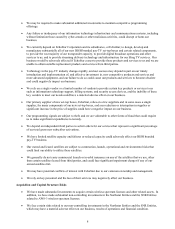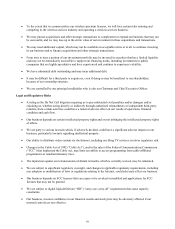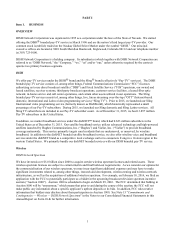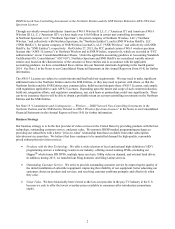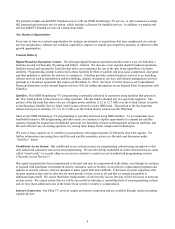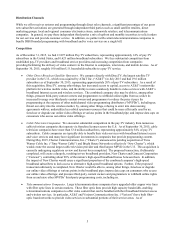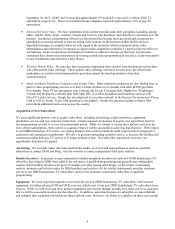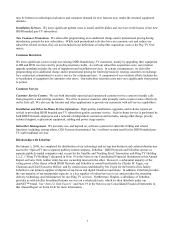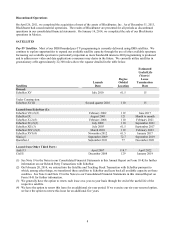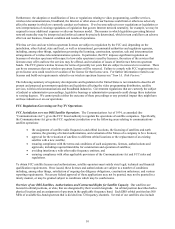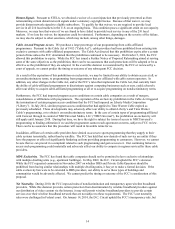Dish Network 2015 Annual Report Download - page 15
Download and view the complete annual report
Please find page 15 of the 2015 Dish Network annual report below. You can navigate through the pages in the report by either clicking on the pages listed below, or by using the keyword search tool below to find specific information within the annual report.5
Distribution Channels
While we offer receiver systems and programming through direct sales channels, a significant percentage of our gross
new subscriber activations are generated through independent third parties such as small satellite retailers, direct
marketing groups, local and regional consumer electronics stores, nationwide retailers, and telecommunications
companies. In general, we pay these independent third parties a mix of upfront and monthly incentives to solicit orders
for our services and provide customer service. In addition, we partner with certain telecommunications companies to
bundle DISH branded programming with broadband and/or voice services on a single bill.
Competition
As of December 31, 2015, we had 13.897 million Pay-TV subscribers, representing approximately 14% of pay-TV
subscribers in the United States, and 0.623 million broadband subscribers. We face substantial competition from
established pay-TV providers and broadband service providers and increasing competition from companies
providing/facilitating the delivery of video content via the Internet to computers, televisions, and mobile devices. As of
September 30, 2015, roughly 100 million U.S. households subscribe to a pay-TV service.
x Other Direct Broadcast Satellite Operators. We compete directly with DirecTV, the largest satellite TV
provider in the U.S., which was acquired by AT&T Inc. (“AT&T”) in July 2015 and had 19.6 million
subscribers as of September 30, 2015, representing approximately 20% of pay-TV subscribers. As a result of
this acquisition, DirecTV, among other things, has increased access to capital, access to AT&T’s nationwide
platform for wireless mobile video, and the ability to more seamlessly bundle its video services with AT&T’s
broadband Internet access and wireless services. The combined company also may be able to, among other
things, pressure third-party content owners and programmers to withhold online rights from us; utilize its
increased leverage over third-party content owners and programmers to reduce the price it pays for
programming at the expense of other multichannel video programming distributors (“MVPDs”), including us;
thwart our entry into the wireless market, by, among other things, refusing to enter into data roaming
agreements with us; underutilize key orbital spectrum resources that could be more efficiently used by us;
foreclose or degrade our online video offerings at various points in the broadband pipe; and impose data caps on
consumers who access our online video offerings.
x Cable Television Companies. We encounter substantial competition in the pay-TV industry from numerous
cable television companies that operate via franchise licenses across the U.S. As of September 30, 2015, cable
television companies have more than 53.0 million subscribers, representing approximately 54% of pay-TV
subscribers. Cable companies are typically able to bundle their video services with broadband Internet access
and voice services and many have significant investments in companies that provide programming content.
During May 2015, Charter Communications, Inc. (“Charter”) announced its pending acquisition of Time
Warner Cable Inc. (“Time Warner Cable”) and Bright House Networks (collectively “New Charter”), which
would create the second largest cable television provider and third largest MPVD in the U.S. This acquisition is
currently undergoing regulatory review and has not been completed. The proposed transaction, if ultimately
completed, will create a duopoly, resulting in two broadband providers, New Charter and Comcast Corporation
(“Comcast”), controlling about 90% of the nation’s high-speed broadband homes between them. In addition,
the impact of New Charter would cause a significant proportion of the combined company’s high-speed
broadband subscribers to lack access to alternative high-speed broadband options. Further, if the proposed
transaction ultimately is completed, New Charter would be able to, among other things, foreclose or degrade
our online video offerings at various points in the broadband pipe; impose data caps on consumers who access
our online video offerings; and pressure third-party content owners and programmers to withhold online rights
from us and raise other MVPDs’ third-party programming costs, including us.
x Telecommunications Companies. Large telecommunications companies have upgraded older copper wire lines
with fiber optic lines in certain markets. These fiber optic lines provide high capacity bandwidth, enabling
telecommunications companies to offer video content that can be bundled with their broadband Internet access
and wireless services. In particular, AT&T and Verizon Communications Inc. (“Verizon”) have built fiber-
optic based networks to provide video services in substantial portions of their service areas. As of


